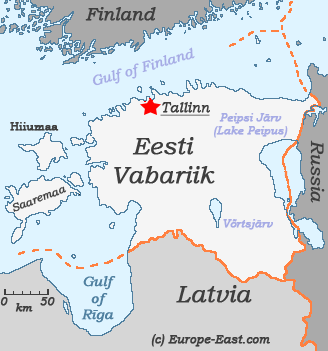Official name
Eesti Vabariik (Republic of Estonia), abbreviated Eesti (Estonia). The name derives from the old tribe of the Aestii (also: Eistr) - a Finno-Ugric tribe once coming from Asia and settling in recent Estonia around 2000 yearsd ago. It doesn't seem to be clear what the name for the tribe exactly means. In medieval times, the area was also refered to as Livland (Livonia).
From 1940 and 1944 resp. until 1991, Estonia was called Эстонская ССР (Estonian Socialist Soviet Republic) - one of the 15 republics of the Soviet Union.
Area & Population

| ||
| Clickable map of Estonia |
45,226 km² - Estonia is twice as large as New Jersey and slightly bigger than the Netherlands.
The population of Estonia is around 1.34 million* (2004) - same as Idaho. The population density is relatively low, adding to that there's a very low birth rate and therefore a negative population growth rate.
According to the census in 2002, about 65.3 % of Estonia's population are Estonians and 30.1% Russians. Furthermore there are minorities such as Ukrainians, Belorusians, Finnish and more. Until the middle of the 20th century, there was a strong German community, but almost all of them left.
Religion
Traditionally, Estonians are mostly Protestants, but nowadays religion doesn't seem to play an important role any longer. Only one third of the population claimed to be religious. Today it's almost a balance between Evangelic-Lutherians and Orthodox Christians.
Time zone
European time: UTC +02 hrs, with daylight-saving time (+1 hour) in summer
Estonian. For most people a rather complicated language, since it doesn't belong to the Indo-Germanic language family (such as English, French etc) but to the Uralo-Altaic family (incl. Hungarian, Turkish, Korean just to name but a few). Closest to Esonian is Finnish, spoken at the opposite shore of the Gulf of Finland. The proximity to Finnish becomes clear in written Estonian, too. However, there are countless loan words from Swedish, German, Russian etc. Finno-Ugric languages are agglutinating, i.e. tenses are mainly expressed by glueing endings on verbs and nouns, forming new and often long words.
Estonian uses a confusingly high number of cases - while German features 4 and Russian 6 grammatical cases, Estonian uses not less than 14 cases. On the other hand, nouns do not have a gender such as in Russian, German or French.
Estonian uses the Latin script; Russian is virtually no where to be seen. But Estonian features some diacritics (see below), among them also the umlaut. It's important to know that Estonian is almost exactly pronounced the way it is written, making things much easier. Therefore, same as in the Finnish language, written Estonian makes intensive use of combinations such as "üü" and "õõ" etc. - it simply means that the vowel is long (but there's a third "extra long vowel" sound which is not displayed in written Estonian. The English word "vast" for example would be written "vaast" in Estonian since it's a long vowel. The stress is usually put on the first syllable.
The following characters do not exist in English or differ from pronunciation in English (note that I can't speak Estonian - most of the following is what an Estonian explained to me):
- A is a clear [a] sound such as the [au] in [laugh].
- AA is a long or very long [A]; it also resembles the English [R] ( ɑ: ).
- Ä is a short, open [a] such as the [ u ] in [ cut ] (phonetical symbol: ɒ)
- ÄÄ is simply the long version of the same sound, i.e. [ɒ:].
- Õ marks the schwa (ə) sound, such as the [the] in [the letter].
- ÕÕ You name it - the long version of the latter, (ə:)!
- Ö - seems to be a sound between the [u] in [nurse] and the [oo] in [good], phonetically [ ʊ ].
- Ü Close to the English [oo].
- ÜÜ Not exactly the long form of the latter but rather close to the [y] in [mystic].
All other letters are pronounced as in Italian/Latin/German. Obviously, Russian is substantially less frequently used as in →Lithuania or →Latvia - that was at least my impression. Many people are fluent in English so it's not difficult to get around. German can be helpful, too - for example when studying the city map: Words like Eesti Kunstimuuseum are easy to understand for German speakers (in English: Estonian art museum).
©2024 Europe-East.com

 Albania
Albania Estonia
Estonia